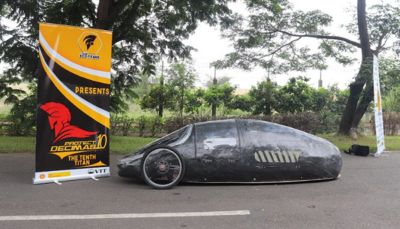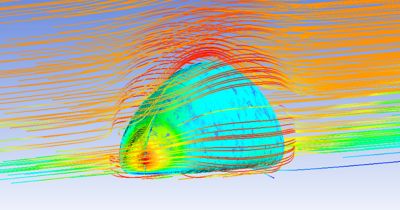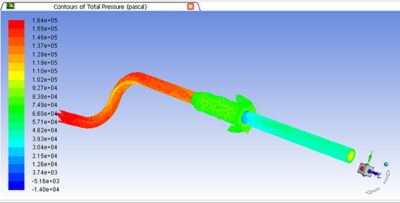-
United States -
United Kingdom -
India -
France -
Deutschland -
Italia -
日本 -
대한민국 -
中国 -
台灣
-
-
產品系列
查看所有產品Ansys致力於為當今的學生打下成功的基礎,通過向學生提供免費的模擬工程軟體。
-
ANSYS BLOG
February 22, 2019
Simulation Helps Students Win a Shell Eco-marathon Fuel Efficiency Race
Every year, student teams from around the world participate in the Shell Eco-Marathon. The competition challenges these teams to design, build and test cars that are optimized for fuel efficiency.
The further your car travels on one tank, the better chance you have at winning the race.
Project Decimas, the tenth car from VIT’s Eco Titans.
Recently, the Eco Titans from Vellore Institute of Technology (VIT) secured first place at the Shell Eco-Marathon in Chennai, India.
Simulation played a big role in the Eco Titans’ strategy to maximize the car’s fuel efficiency and safety. Thanks to a student team sponsorship from Ansys and the Ansys student community, the team received the software, training and technical help they needed to win on race day.
Simulation Played a Key Role in Winning the Shell Eco-Marathon
The Eco Titans participated in Shell Eco-Marathon’s prototype internal combustion engine (ICE) race. The team’s winning gasoline-based vehicle achieved a mileage of 129.2 km/L (304 mpg). This secured the team the top prize of 300,000 INR ($4,250 USD).
It wasn’t magic that helped Eco Titans win this fuel efficiency race — it was simulation. Specifically, simulation helped the team build a prototype which was lighter and more aerodynamic than previous models.
To achieve this, Eco Titans performed various simulations on critical parts of the vehicle, including the chassis, shell, wheel hub and exhaust pipe.
Simulation Lightweights the Chassis of a Shell-Eco Marathon Car
The chassis is the heaviest part of the Eco Titans’ car. Minimizing the weight of the chassis is a good way to improve fuel efficiency.
Static structural analysis of the chassis
However, the team needed to make sure that the chassis still has the strength to withstand all the static and dynamic loads that can be placed on the car — especially during a crash.
To achieve this balance, the Eco Titans designed a roll-cage in Ansys Mechanical and tested it against various loads. By conducting simulations, the team was able to minimize the weight of the chassis by 33 percent without affecting safety.
CFD Reduces the Aerodynamic Drag on a Shell-Eco Marathon Car
The next big project that the Eco Titans tackled was to optimize the aerodynamics of the vehicle’s shell.
Aerodynamics studies of the car’s shell helped Eco Titans reduce the drag on the car.
The team used computational fluid dynamics (CFD) simulations to reduce the drag on the car in motion.
These CFD studies were performed in Ansys Fluent. The team tested various iterations of the shell until they found one that minimized drag.
Structural Simulations Ensure the Strength of a Wheel Hub
A failing wheel hub is one of the worst things that can happen on race day, because these parts can’t be repaired or replaced quickly.
Structural analysis of the wheel hub
Eco Titans used Mechanical to optimize the strength of its wheel hubs. Specifically, the team iterated the material and shape of the wheel hub until they reached a design that limited deformation.
CFD Minimizes Engine Backpressure by Optimizing a Car’s Exhaust Pipe
The geometry of the exhaust pipe was also optimized using Fluent.
Exhaust pipe analysis using Fluent
The aim of the simulation was to analyze and minimize the back pressure inside the pipe under various conditions. Eco Titan needed to limit the back pressure because it can have a negative effect on engine efficiency.
After iterating the pipe’s length and bend radius, the team was able to minimize the back pressure on the engine.
Eco Titan’s quest to optimize its car’s fuel efficiency is a continuous effort. The team spends countless hours simulating and tinkering with the car before every Shell Eco-marathon race because the competition is never far behind.
Learn how to apply for an Ansys student team sponsorship here.















